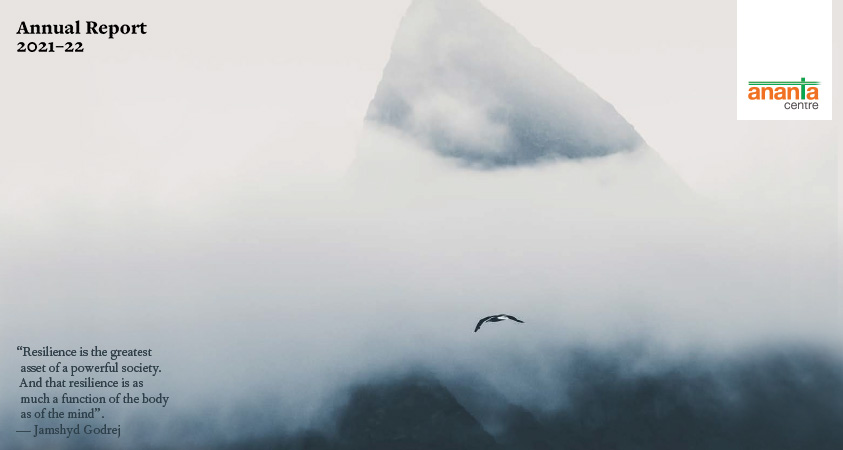|
Fiscal deficit in 1st
half of 2023-24 contained at 4.9 % of GDP
On the last day of November, two
sets of data were released by the Union government– one by the Controller
General of Accounts (CGA) and the other by the National Statistical
Office (NSO). The CGA data provided a glimpse of the reasonably healthy
state of the Centre’s finances till the end of October 2023, while the
NSO data gave an indication of the continued momentum in economic growth
till the first half of 2023-24.
At Rs 8.04 lakh crore, the
Centre’s fiscal deficit at the end of October 2023 was 45 per cent of the
annual target, almost the same level it was around the same time in 2022.
Extrapolating the gross domestic product (GDP) data for the second
quarter of 2023-24, it also became evident that the Centre’s fiscal
deficit in the first half of the year was only 4.9 per cent of GDP, one
percentage point lower than the annual target of 5.9 per cent. This
implied that the government could spend a little more in the months ahead
in the run-up to the general elections, provided revenue flows remained as
buoyant as they were in the first half of the year.
Slowdown in tax revenue with
reined in expenditure
There are, however, early signs
of a slowdown in the government’s gross tax revenues. The growth in gross
tax revenues in April-October 2023 was down to 14 per cent, compared to
16 per cent in the April-September period of 2023. This was still
comfortable as the 2023-24 Budget had projected a growth rate of 10 per
cent for the full year. But the net tax revenues growth (which impacts
the fiscal deficit) was down to 11 per cent at the end of October,
compared to 15 per cent growth till the end of September. Remember that
the Budget had projected a growth rate of 11 per cent in its net tax
revenue collections in 2023-24 over the previous year and by the end of
the seventh month, the growth rate is now down to that number, thereby
denying the leeway of expenditure slippages that the government had been
enjoying in the first half of the year. What led to the tax revenue
slowdown? While personal income-tax collections growth has stayed at 31
per cent, there is a perceptible fall in the corporation tax growth from
20 per cent in April-September to 17 per cent in the April-October period
of 2023. The drop in the Customs collections growth in this period is sharp.
Even non-tax revenues growth has seen a slow-down. Not surprisingly, the
government has already reined in its expenditure. Its capital expenditure
grew by 43 per cent in the first half of 2023-24. But in the first seven
months of the current year, that growth has slowed to 34 per cent, just
as revenue expenditure growth in the same period has slowed from 10 per
cent to 6.5 per cent. The government may still meet its fiscal deficit
target of 5.9 per cent for 2023-24. But achieving that goal would depend on
a pick-up in tax revenue growth and a measurable squeeze on revenue
expenditure, which however could be difficult in view of the forthcoming
election season.
Q2 GDP growth fuelled by
manufacturing & construction
On the GDP growth front, there
was pleasant surprise for most experts and analysts tracking the pace of
activity in the Indian economy. Reserve Bank of India Governor
Shaktikanta Das had indicated in October that the GDP numbers for the
second quarter of 2023-24 would be higher than most people expected them
to be. That is precisely what happened when the numbers were released on
November 30. India’s GDP for July-September 2023 grew by 7.6 per cent.
This growth was fuelled by a 14 per cent rise in the manufacturing sector
(helped by a low base-effect with a contraction of over 3 per cent in the
second quarter of 2022-23) and a 13 per cent rise in the construction
sector – both of which should have augured well for employment growth in
the economy. Agriculture disappointed with a marked deceleration in its
gross value-added growth of just 1.2 per cent, almost half of what it was
a year ago. A marked declaration in the services sector growth is also a
cause for concern. On the expenditure side, the government’s spending
maintained double-digit growth at 12 per cent, although a worrying
development was a 3 per cent rise in private final consumption
expenditure, casting doubts on prospects of a demand revival. An
encouraging development was the 11 per cent rise in investments, which
was now estimated at a healthy 35 per cent of GDP.
Challenging task for achieving
6.5% growth in 2023-24
What does the year look like,
based on a GDP growth rate of 7.7 per cent in the first half of 2023-24?
Note that the growth in the first half of the current year marked a
deceleration from 9.5 per cent in the same period of 2022-23. Maintaining
the first-half growth rate in the second half of the current year would
be a tough task. If the full year’s growth rate is to be 6.5 per cent, as
the RBI is projecting, the second half of the year must grow by at least
5.4 per cent. Given the signs of a slowdown in demand, both kharif and
rabi agricultural output not looking very promising and the world economy
remaining under stress, a growth rate of 5.4 per cent in October-March of
2023-24 (last year, the same period saw a growth rate of 5.3 per cent)
would be an ambitious goal.
Growing concerns over retail
loans & financial sector health
In the wake of sustained growth
in retail credit, India’s financial sector has come under scrutiny from
the regulator – the Reserve Bank of India (RBI) – and even the central
government. The latest report of TransUnion Cibil Credit Market Indicator
(CMI) shows that retail credit for the quarter ended June 2023 grew by 15
per cent. The CMI report noted that during this period, consumer loans
rose by 20 per cent and the increase in other retail credit segments were
also in double digits – 12 per cent for personal loan and property loans,
13 per cent for car loans and 18 per cent for two-wheeler loans. The only
sector where loans disbursal dropped was for the housing sector – a drop
of 6 per cent. The RBI’s concerns arose not so much from the growth in
retail loans as from the banks’ increasing reliance on high-cost
deposits, an algorithm-based loan approval system, especially by fintech
firms, the possibility of contagion risks spreading, and the high
interest rates charged by microfinance institutions. In no uncertain
terms, RBI Governor Shaktikanta Das told banks and non-banking financial
companies (NBFC) to avoid “all forms of exuberance”. This warning came
days after the RBI had announced a few macro-prudential measures in the
overall interest of sustainability and by way of pre-emptive measures. On
November 16, the RBI had increased the risk weighting for unsecured
personal and credit card loans from 100 per cent to 125 per cent, which
meant that banks and NBFCs had to set aside more capital while extending
such loans. Consequently, these lenders were also expected to raise
interest rates on such loans. Reacting to this, stocks of major listed
banks fell by 1 to 3 per cent on a single day’s trading. But the central
bank remained unnerved as there were reports of it undertaking a full
review of its framework for penalties for regulated financial entities
when they fail to adhere to governance norms. Even Finance Minister
Nirmala Sitharaman supported the RBI move to curb lending exuberance by
asking banks and NBFCs to remain cautious.
Inflation worries trouble
Indian economy & the RBI
Highlighting a major area of
weakness in the Indian economy, the latest retail inflation data,
released by the National Statistical Office (NSO) in November, showed
that in October 2023 rural retail inflation remained much higher than the
urban inflation rate, for the fourth consecutive month. Indeed, in 18 of
the 22 months from January 2022 to October 2023, the rural inflation rate
was higher than urban inflation. And this at a time when the government’s
welfare measures for rural India have been strengthened. In October 2023,
rural inflation was estimated at 5.12 per cent, while urban inflation was
4.62 per cent. An analysis showed that the higher rural inflation was
driven largely by higher prices of food and primary cereals. This was
aggravated by a series of adverse weather conditions. And since the
Consumer Price Index has the largest weightage for the food and beverages
sector, any rise in prices in this category affects the rural population
substantially more than the urban population. In contrast, for the
seventh month running, inflation based on the Wholesale Price Index (WPI)
remained in negative territory and hit a three-month low of -0.52 per
cent. In other words, the Indian economy has been witnessing deflation in
wholesale prices since April 2023. But retail inflation continued to
cause worries for the Reserve Bank of India’s (RBI) Monetary Policy
Committee as it has been consistently staying above the target of 4 per
cent. In October 2023, it declined to 4.87 per cent for the second
consecutive month, a level that was a five-month low. A favourable base
effect and moderation in prices of clothing, footwear, housing, fuel and
transport helped in retail inflation coming down from 5.02 per cent in
September 2023. Concerns over inflation were also shared by the RBI.
Governor Shakitakanta Das admitted in a public meeting that India was
vulnerable to recurring and overlapping food price shocks, even though
there was some moderation in inflation in recent weeks. He, therefore,
justified the monetary policy stance remaining watchful and actively
disinflationary to progressively align inflation to the target while
supporting growth. Coming as it did less than a month before its
bi-monthly monetary policy review, the RBI Governor’s statement was a
fair indication of the interest rate regime that could prevail in the
next couple of months.
Foreign equity inflows &
outflows continue to decline
In a signal that all is not well
on the investment front, both the inflows and outflows of India’s foreign
investment have been declining in the first few months of the current
financial year. The April-September 2023 period saw India’s inward flow
of foreign equity investments falling by 24 per cent to $20.5 billion.
The decline could be explained because of the global investment climate
getting worse. Indeed, global foreign investments, according to the
Organisation for Economic Cooperation and Development or OECD, fell by 30
per cent in the first half of 2023 (January-June) to $727 billion. In
other words, the rate of decline in inward flows of foreign equity into
India at $20.5 billion was a little lower than that of the global
investment flows in a broadly similar period. The declining trend in
India’s foreign equity inflows was first noticed in the Covid year of 2021-22,
when they fell by 1.4 per cent to $58.77 billion over the previous year.
But the fall in 2022-23 was steeper at about 22 per cent at $46 billion.
It seems the declining trend has got worse in the first half of 2023-24
with a fall of about 24 per cent. Even India’s outward foreign direct
investments (FDI) have seen a declining trend. In October 2023, such
investments fell by 29 per cent to $1.88 billion. Such outward
investments are mostly made by Indian companies in their overseas
subsidiaries or new ventures abroad. A global economic slowdown has
certainly made an adverse dent on India’s foreign investment outflows as
well. Outward flows of foreign investment include equity, loans and
guarantees. Significantly, the decline is most pronounced in equity and
loans, while the value of guarantees issued by Indian companies for its
investments abroad has seen only a small decline.
Trends in foreign trade in
goods & services offer no relief
There has been no respite from
India’s economic stress over its performance on the foreign trade front.
Its merchandise exports grew by 6.2 per cent to $33.6 billion in October
2023, but imports rose at a higher pace of 12.3 per cent to $65.03
billion, which as a result widened its trade deficit for the month to a
record high of $31.5 billion. The government believed that the October
performance was a signal of a recovery. That belief perhaps sprang from
the fact that the 6 per cent exports growth in October 2023 was the
highest in the last 11 months and that as many as 22 of the 30 sectors
saw an increase in exports. Even the imports growth of 12 per cent was
the fastest in the last 13 months. A rise in imports is often interpreted
as a sign of industrial revival. But the 12 per cent growth was fuelled
not by imports of industrial raw materials or components, but by a 95 per
cent increase in imports of gold to $7.2 billion and another 125 per cent
spurt in imports of silver to $1.3 billion in October. Taken together
with the fact that imports in about a third of the 30 sectors contracted,
the signals on higher imports were not encouraging. There was some relief
from services exports, which rose by 13.4 per cent to $28.7 billion in
October 2023. With services imports rising by 6 per cent to $14.3
billion, the services trade balance was in a surplus of $14.4 billion.
The services trade surplus thus nearly halved the merchandise trade
deficit during the month.
GST collections rise, car sales
& UPI payments up, but PMI dips
The month of November has seen
buoyancy in a few high-frequency indicators of the state of the economy.
Collections of goods and services tax (GST) in October (pertaining to the
pace of economic activity in September) rose by 13 per cent to Rs 1.72
lakh crore, which was the second highest monthly figure, next only to Rs
1.87 lakh crore recorded in April 2023. The rise was largely attributed
to strict anti-evasion steps and a bump in festival-season consumer
spending. The average monthly GST collections in 2023-24 so far have now
risen to Rs 1.66 lakh crore, 11 per cent higher than in the same period
of 2022-23. At this rate, GST collections in 2023-24 could well be over
Rs 20 lakh crore, against Rs 18.06 lakh crore in the previous year,
indicating how the new tax system has stabilised and is generating a reasonable
and sustainable growth rate. The Purchasing Managers’ Index, released by
S&P Global, however, showed that the level of confidence in the
economy’s buoyancy has taken a hit. For the second consecutive month, the
PMI for October fell to 55.5, an eight-month low figure. In September
2023, the PMI was 57.5. Any figure above 50 suggests an expansion, but a
falling index also shows that the confidence level in manufacturing
buoyancy has declined. Sales of passenger vehicles and financial
transactions through Unified Payments Interface or UPI, however, showed
an uptick. Passenger vehicle sales in October grew by over 16 per cent to
391,472 units, while UPI transactions reached their highest-ever value at
Rs 17.16 lakh crore in October, an increase of 9 per cent over the
previous month.
Disinvestment remains a cause
for disappointment
The Union government’s
disinvestment programme has taken a big hit in the current financial
year. Against a target of mobilising Rs 51,000 crore through sale of the
government’s equity in public sector undertakings (PSU) in 2023-24, the
receipts as at the end of November 1, 2023 were estimated at only Rs
8,000 crore. It is reasonably certain that the target would be missed in
the current year as well. Indeed, the targets set in all the four
previous years were missed. Against a target of Rs 1,05 lakh crore in
2019-20, the actual receipts were less than half at Rs 50,299 crore. In
2020-21, the receipts at Rs 32,885 crore were just about 16 per cent of
the target of Rs 2.1 lakh crore. The performance was worse in 2021-22,
when the actual receipts from disinvestment at Rs 13,534 crore were only
7.7 per cent of the target of Rs 1.75 lakh crore. Of course, the Covid
pandemic contributed to the massive shortfall in meeting these targets in
2020-21 and 2021-22. Subsequently, the government had become a little
more realistic and set a target of Rs 65,000 crore in 2022-23. But even
in a non-Covid year the receipts at Rs 35,293 crore were almost about
half of the target. A similar trend is likely in the current financial
year, confirming the view that on PSU disinvestment the government in the
last five years has tried to be ambitious with its targets, but has
failed to achieve them. With the sole of exception of the sale of Air
India to the Tatas, there was no other privatization, even though the
government made promises of privatising state-owned banks and PSUs. The
Covid pandemic did play a spoilsport, but the government too has fared
poorly in successfully executing its disinvestment strategy.
The previous issues of Indian
Economy Review are available here: LINK
Supported by
|
























